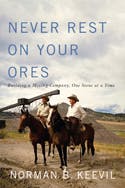
Book Review
Never Rest on Your Ores: Building A Mining Company, One Stone at a Time, 2017
By Norman B. Keevil
The name Norman Keevil is to Canadian mining what H.R. Macmillan is to the nation’s forest industry. Norman Keevil Senior and Junior devoted their working careers to discovering, studying, extracting, processing, and buying and selling a range of minerals and mining firms around the world. Together, they played pivotal roles in creating one of Canada’s few remaining behemoths in this field, Teck-Cominco. In Never Rest on Your Ores: Building a Mining Company, One Stone at a Time, Keevil Jnr. recounts this remarkable story, and it is well worth exploring.
This is business history told in the populist tradition. Keevil Jnr. does not use footnotes or endnotes, and he does not base his story on archival research. Instead, he draws upon his own rich personal experiences – and those of his father and colleagues – to recount the remarkable tale of how a tiny, Canadian based geophysics and prospecting firm in the 1950s became, through a combination of guile, luck and brains, the mining powerhouse that Teck-Cominco is today.
This approach is one of the book’s strengths because Keevil Jnr. is a gifted story-teller. He employs his highly accessible writing style to transport the reader back in time to the mining frontiers on which rich new veins of ore were uncovered and the boardrooms in which the intense negotiations were conducted for acquiring a new operation or selling an existing one. He also peppers the tale with a scattering of anecdotes that elicit the gamut of emotions from humour to fear. The reader cannot help but chuckle, for example, at learning of the disgruntled shareholder – an older woman – expressing her displeasure with the firm’s performance at its annual general meeting year after year, only to signal defiantly that she was putting an end to her pilgrimages by slinging a rock at Keevil (she missed and hit Teck’s lawyer).
The book also benefits from the fact the Keevils had an insider’s perspective on virtually all the major events in Canadian mining history in the modern era. In Forrest Gump-like fashion, one or both of them were on the ground floor in the late 1970s, for instance, when China was waking up from its century-long slumber to emerge as a global economic powerhouse and when the Bre-X scandal was occurring.
In terms of content, Never Rest on Your Ores provides extraordinary insight into the rough and tumble world that was the Canadian mining industry over more than the last half century, and the myriad vagaries that could determine an enterprise’s fate. The story begins with the intersection of three seminal events in the 1910s: the construction of the Teck-Hughes gold mine near Kirkland Lake, Ontario, the creation of the Consolidated Mining and Smelting Company in British Columbia, and the birth of Keevil Snr. in Saskatchewan. He became a geologist and by the end of the Second World War, he was running his own geophysical consulting firm and developing several new technologies for locating valuable minerals. He and his associates used a relatively simple method – drilling holes on long weekends, however, to discover one of Canada’s purest copper deposits on an island in Lake Temagami in the mid-1950s; the resulting mine became the heart of his business. Keevil Jnr. was already helping his dad in the latter’s growing prospecting and mining enterprise, which soon acquired a controlling interest in Teck-Hughes, other operating mines in Quebec and northwestern Ontario, and an oil firm in Saskatchewan. In 1962, Keevil Snr. created Teck Corporation as a holding company for his consulting, exploration and mining operations.
The book’s clever title speaks to the mantra that guided Teck’s modus operandi from very early on. (Keevil Snr. was an avid canoeist and encouraged his fellow paddlers by saying, “never rest on your oars”.) For a mining firm, Keevil Jnr. repeatedly notes, it was essential to search practically continuously for additional ore deposits – or the interests that owned them – because resources that it was already extracting would inevitably be depleted. He stresses that ore reserves are simply one prong in the trident of essential ingredients needed to create a successful mining company. The other two are the right personnel to “find, build, and manage the mines, and the financial strength that will enable it to grow.” (127)
The rest of the book thus examines on a decade-by-decade basis Teck’s never-ending quest to assemble this triumvirate of critical components. Keevil Jnr. recounts how in the 1960s the firm conducted an abortive prospecting campaign in Chile and abandoned a joint venture in New Brunswick with German-giant Metallgesellschaft because of environmental concerns. During the following decade it consolidated its holdings, created an avant-garde share structure and moved its headquarters to Vancouver, acquired and established new mines in British Columbia, Quebec and Newfoundland, teamed up again with Metallgesellschaft, and even temporarily entered the cattle ranching business. In the 1980s, Teck grew significantly by gaining a share of new gold mines in Ontario and Quebec and cooperating with Metallgesellschaft to buy a controlling interest in Cominco, but the company also lost its guiding light, Keevil Snr.. During the last decade of the century, Teck expanded into Latin America, became the world’s second largest seaborne metallurgical coal producer, reaped a windfall from selling its stake in the Voisey’s Bay deposit in Newfoundland, and developed a highly successful relationship with the Japanese copper miner and smelter, Sumitomo. The new millennium witnessed Teck merging with Cominco (thus the firm’s present name), enjoying a super-cycle and then intense volatility in the mining sector, and Keevil Jnr. stepping down as Teck-Cominco’s president and CEO.
Never Rest on Your Ores ultimately delivers an engaging and rewarding read. Its appeal would be particularly strong to geologists or veterans of the Canadian mining industry, but the lessons it offers about how to succeed in business and life gives it broad appeal.
Mark Kuhlberg
Laurentian University